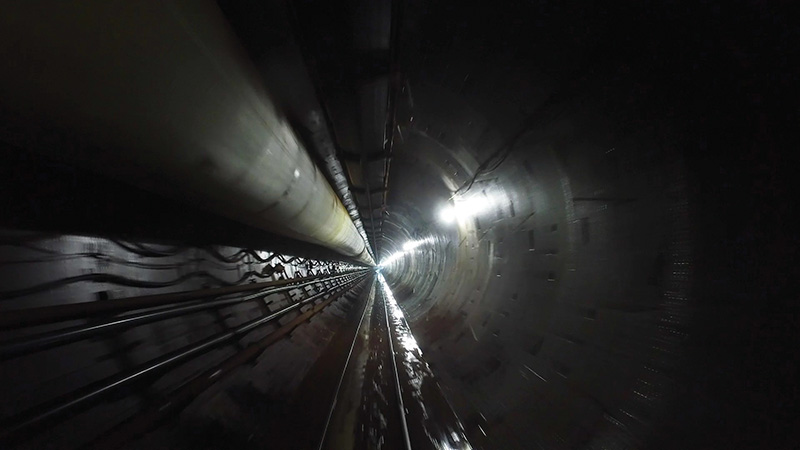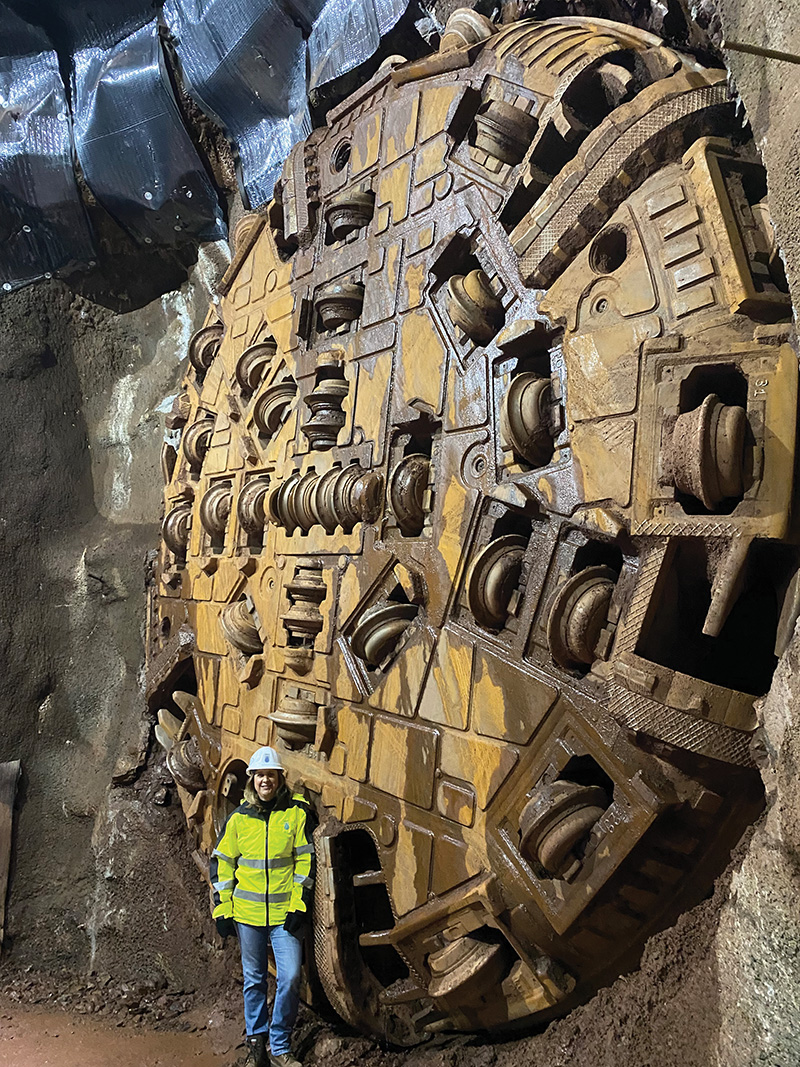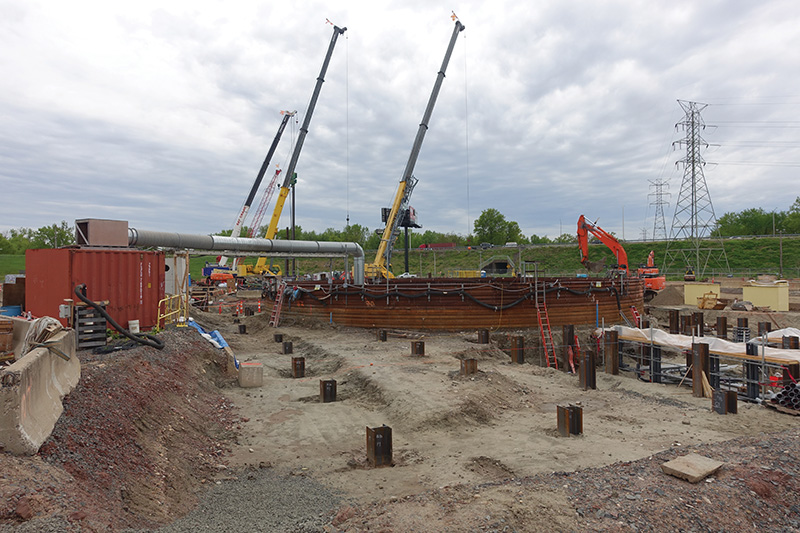 This article appears in the Fall 2024 issue
This article appears in the Fall 2024 issue

A dark look at a section of the 18-foot diameter, 4-mile-long South Hartford Conveyance and Storage Tunnel. Photo courtesy of the MDC.

Tunneling for Cleaner Water
By Steve Gephard and Sally Harold
The Connecticut River is one of the cleanest major rivers on the East Coast, mostly free of untreated sewage. The diverse aquatic species that live in the river are dependent on clean water and sufficient levels of oxygen in that water. The basic ecological impact of sewage in a stream is reduced oxygen. Decomposition of waste in a stream happens quickly, but the process eats up the oxygen present in the water. When there’s too much waste being decomposed, there may not be enough dissolved oxygen in the water for fish and other aquatic life. In the late 1960s, the lower Connecticut River experienced massive fish kills daily during the summers when there was insufficient oxygen found in river water. (Warm water holds less oxygen than cold water, so summer pollution events are usually more deadly.)
Fish are not the only ones to appreciate the clean river. Boaters and swimmers enjoy this iconic river but are sometimes advised to stay clear. During normal dry spells, the river runs clean, free of any sewage because human waste now passes through municipal sewage treatment plants. But during wet periods, there is still a problem.
Long ago, cities began to install storm sewers to collect and direct rainwater to the nearest river to minimize street and neighborhood flooding. As cities grew and outhouses were abandoned in favor of indoor plumbing, human waste had to be collected and disposed of, and since there were already these nifty underground drainage pipes leading to the river, they just tied the so-called “sanitary sewers” into them.
As pollution became a real problem in the 20th century, sewage treatment plants (STPs) were built, and those existing dual-purpose pipes were directed to the STPs for treatment of the waste and runoff. These are called combined sewer systems, and many riverside communities have them. Those STPs have limited processing capacity, and in order to prevent the sewage from backing up in the cities when the plant’s capacity is exceeded, the excess flow is released directly into the river (without processing). This happens during large storm events, which are happening with increasing frequency and intensity. The pipes where these events occur are called Combined Sewage Overflows, or CSOs. Discharges at these CSOs are still common and are the reason why people are advised not to swim in the river after heavy rains.

Susan Negrelli, Director of Engineering for the MDC, stands in front of the cutting head of the tunnel borer after it broke through the West Hartford end of the tunnel. Photo courtesy of the MDC.
Several communities along the river have CSOs (see below), but the Hartford, Connecticut, region is a major source of untreated inputs during severe weather. Hartford is served by the Metropolitan District Commission (MDC), a chartered municipal corporation created by the State of Connecticut in 1929 to provide water and sewer services to eight member towns. The MDC has thirty-eight CSO discharge locations that empty into local waterways, the Connecticut River, and Park River. The Park flows into the Connecticut.
In 2006 the MDC entered into a fifteen-year consent order/decree with the Connecticut Department of Energy and Environmental Protection (DEEP) and the US Environmental Protection Agency (EPA). More recently the MDC has developed a forty-year integrated plan to reduce untreated discharges. The MDC is in Phase I of the plan, which will extend to 2030 and includes completion of construction of a massive underground storage tunnel. We recently visited part of the construction site in the South Meadows area of Hartford and met with MDC’s Susan Negrelli, Director of Engineering, and Nick Salemi, Communications Administrator, to learn more.
The official project name is the South Hartford Conveyance and Storage Tunnel (SHCST), and its operating concept is similar to a flood control dam. This underground tunnel will normally be empty but when heavy rains come and the combined flow exceeds the capacity of the local combined sewers, instead of being discharged into the river via the CSOs, the combined waste water will drain into this underground tunnel, where it will be held until the system once again has sufficient capacity, and the stored waste water will be pumped to the STP for treatment prior to discharge into the river. Once pumped empty, the SHCST will have room to store more combined wastewater during the next storm. A simple concept? Perhaps, but it is an enormously complicated and expensive construction project.
The SHCST was bored out of solid rock about two hundred feet below the surface, and it is eighteen feet in diameter and four miles long, extending from the South Meadows area (visible from I-91) to the Talcott Road area of West Hartford! It has the capacity to hold 41.5 million gallons of untreated combined effluent. A custom-made tunnel boring machine was constructed in Germany and shipped to Hartford. Nicknamed “Iris,” the machine—which resembles a cross between a locomotive engine and a worm-like monster from the 1990s Kevin Bacon movie called Tremors—is 400 feet long. The front end of Iris has grinding teeth that can chew through bedrock. The tail end has an expandable conveyor belt that collects the ground rock (called “tunnel muck”) and sends it back to the entry shaft for removal and disposal. An estimated 800,000 tons of material were removed from the tunneling operation. Teams of workers operated Iris during three daily shifts for over three years with twenty people down in the tunnel and many support workers above ground.

Work continues on the multimillion-dollar pumping station at the MDC’s South Meadows complex, visible from I-91. Image Credit: Steve Gephard.
Before the contractor, Kenny-Obiyashi Joint Venture, even reached bedrock, it had to excavate through seventy vertical feet of “overburden,” a combination of gravel, sand, soil, and rocks that had been deposited in the valley by the river for millennia. As the tunnel was bored, it was lined with concrete to prevent tunnel muck (and eventually untreated sewage) from contaminating the groundwater by seeping out through fissures and fractures in the bedrock tunnel.
Before they could drill the tunnel under the city, the MDC had to get easements from over 200 property owners, whose property rights apparently extend to the center of the earth! In addition to the underground work, considerable re-plumbing of sewer pipes at street level will be needed to connect the existing network to the underground tunnel. Included in the project are seven “drop shafts” that are vertical shafts that give the MDC access to the tunnel and serve as connections between the street level sewer pipe networks and the tunnel. Elaborate air treatment systems housed on top of each drop shaft will filter odors from the air escaping the tunnel when it fills with sewage.
The tunnel boring is now complete, but the system will not become operational until late 2026. It will take the next two years to complete construction of a complex pumping station at the site. Today, passing motorists along I-91 can see several cranes working there. This station will be capable of pumping up to 50 million gallons per day from the tunnel through a fifty-four-inch forced main to ground level for treatment at the STP.
The tunnel construction cost approximately $279 million and the pumping station is expected to cost another $115 million. Of course, there will be plenty of other costs associated with Phase I, including the street-level improvements and the expansion of the STP to handle the increased volume of effluent. Additional costs will be incurred in future phases during the forty-year plan. The costs will be partially covered by DEEP and EPA grants as well as rate-payers.
Hartford is not the only municipality on the river dumping untreated inputs into the river during severe weather. Downstream, Middletown, Connecticut, is close to finishing a multi-year project to physically separate their sanitary and storm sewers by digging up the streets and installing new pipes.
Upstream, in Massachusetts, Chicopee adopted an integrated plan in 2016. When the current Phase 5A is completed, the city will have removed 77 percent of its average annual untreated sewage volume. The plan, however, appears to be stalled for lack of funds. In Holyoke last September the city signed a consent order with the US EPA and the State of Massachusetts to eliminate sewer discharges, but little progress has occurred to date. Similarly, Springfield is under order, but it is unclear whether any progress has been made. These projects take millions of dollars to implement, and the Hartford MDC has been more successful in securing funds than these upstream communities.
The CSO problems of Hartford MDC will not end with Phase I. Much work needs to be done in the northern part of Hartford in future phases. However, there’s already reason to celebrate. Before this work began, in a typical year the system overflowed one billion gallons of combined stormwater and untreated wastewater into the river. In the first fifteen years of this project, the MDC has already reduced that by fifty percent, and when the tunnel goes into operation in 2026, the discharges will be reduced by another fifty million gallons. By the time the forty-year plan is completed, those discharges will be significantly reduced. There still will be some isolated CSO discharges during extreme weather events but the volume and frequency will be a fraction of what they had been. All of this promises an even brighter future for the Park River, the Connecticut River, and Long Island Sound; for all of us who swim and boat; and for all of the fish and other aquatic organisms that live Below the Surface.
Steve Gephard was a fish biologist with the Connecticut Fisheries Division. He continues to serve as a US Commissioner to the North Atlantic Salmon Conservation Organization.
Sally Harold worked on dam removal at The Nature Conservancy.

